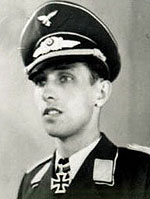

Eagles of the West
by Robert Taylor
| - Helmut Wick - |
The Battle of Britain will be remembered as one
of the most important battles ever fought. It is the setting for "Eagles of the West", which portrays the Luftwaffe’s leading Battle of Britain Ace -
Helmut Wick. Recently promoted Gruppenkommandeur of I./JG2 ‘Richthofen’, Wick is seen
leading a group of Bf109s back to their base in Normandy following a sweep over the English
Channel and Normandy coast during the closing stages of the battle. |
| Overall size: 23⅛" x 27¾" | Image size: 13" x 19½" |
| The Archive Presentation |
| This limited edition print signed by three prominent Luftwaffe Aces, has been conservation mounted with triple-mats and a shadow-box layer to include the original signature of the Luftwaffe's leading Battle of Britain Ace - Helmut Wick. Also included are the signatures of JG-2 (Richthofen) veterans Siegfried Lemke, Ernst Giefing and Hugo Dahmer plus a high quality reproduction officer's breast eagle. |
| Archive Presentation | Conservation matted to include the signature of Helmut Wick. - (one copy available) | ||
| SOLD |
Helmut Wick signature Wick was one of the most significant Luftwaffe aces, but while his career was brilliant, it was also short and there are few examples of his signature to be found. |
 |
| The signatures | |
| Major Helmut Wick - Knight's Cross of the Iron Cross with Oak Leaves / 56 victories - (matted) | |
| Leutnant Siegfried Lemke - Knight's Cross / 70 victories - (matted) | |
| Generalleutnant Günther Rall - Knight’s Cross with Oak Leaves & Swords / 275 victories - (signed on the print) | |
| Leutnant Hermann Neuhoff - Knight’s Cross / 40 victories - (signed on the print) | |
| Major Erich Rudorffer - Knight’s Cross with Oak Leaves & Swords / 222 victories - (signed on the print) | |
| Oberleutnant Hugo Dahmer - Knight’s Cross / 45 victories - (matted) | |
| Feldwebel Ernst Giefing / 4 victories - (matted) | |
In January 1939, he was transferred to 1./JG 53, flying the Messerschmitt Bf 109 under the command of Werner Mölders. Wick was transferred to JG 2 on 30 August 1939, assigned to 3./JG 2 and served with the unit in the air defence of Berlin during the Polish Campaign. He recorded his and the Geschwader’s first victory on 22 November 1939 when he shot down a French Hawk 75 fighter near Strasbourg. He was particularly successful during the French campaign recording 12 confirmed and two unconfirmed victories, including four French fighters shot down on 5 June to record his fourth through seventh victories and his 10th victory shot down on 8 June. Wick was to have continued success during the Battle of Britain. He was appointed Staffelkapitän of 3./JG 2 on 1 August 1940, although he had been leading the unit since 23 June. He recorded his 19th and 20th victories on 25 August and on 26 August claimed a further two to take his score 22. For this feat, Oberleutnant Wick was awarded the Ritterkreuz on 27 August 1940. On 4 September 1940, he received promotion to the rank of Hauptmann and took command of 6./JG 2. Wick was appointed Gruppenkommandeur of I./JG 2 on 9 September. On 5 October, he shot down five RAF fighters in the Isle of Wight areag gaining him the immediate award of the Eichenlaub. Further promotion followed and, at 25 years of age, Wick was the youngest Major in the Wehrmacht. Wick was appointed Kommodore of JG 2 on 20 October 1940. |
|
Günther Rall was a young pilot with III./JG52 at the outbreak of war, and quickly demonstrated his natural ability and leadership qualities. He scored his first victory early in the Battle of France, and by July 1940 was leading 8./JG52. After transferring to the Eastern Front his victories soon mounted but he was hospitalized following a crash. Returning to combat as Kommandeur of III./JG52, he gained the Wing's 500th victory, before being posted Kommandeur of II./JG11 on the Western Front, flying high altitude intercepts in Me109Gs. He was later Kommandeur of JG300, and finished the war as the 3rd highest Ace in history with 275 victories. |
At the outbreak of World War Two, Neuhoff was serving with 3./JG 53. but was later transferred to III./JG 53. He recorded his first victory on 2 March 1940 when he shot down an RAF Hurricane southwest of Diedenhofen. He added a further four victories during the French campaign and participated in the Battle of Britain gaining a further four victories. Operating over the Eastern front, Neuhoff gained considerable success, reaching 30 victories. Neuhoff accompanied III./JG 53 when it was relocated to the Mediterranean theatre in November 1941. Following a lengthy spell of instruction and officer training Neuhoff returned to combat duty in March 1942. III./JG 53 was now based in Sicily operating over Malta and Neuhoff claimed four RAF fighters shot down over and around the island. On 9 April, Neuhoff was appointed acting Staffelkapitän of 6./JG 53. Neuhoff led his new Staffel over Malta and attacked three RAF Spitfire fighters. During the subsequent combat Neuhoff was shot down. He baled out to become a prisoner of war. |
Erich Rudorffer began his career with JG2 during the Battle of France, he then served in the Battle of Britain alongside top aces such as Helmut Wick and Gunther Seeger. His Gruppe was then relocated to northern Africa. Now flying the heavily-armed Fw190, he began to demonstrate his skill at downing a number of aircraft on a single sortie. On the 9th February 1943 he claimed eight British aircraft. |
|
|






